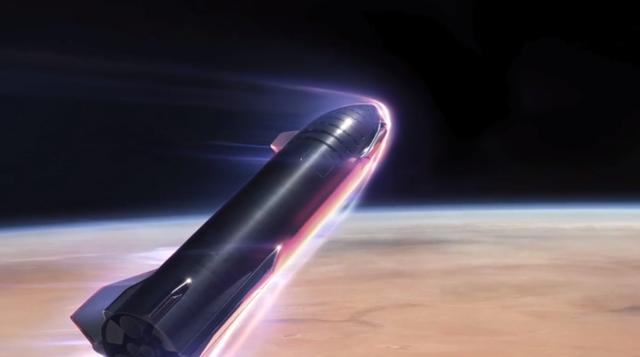Spacex's starships have attracted the attention of the world, with mixed reviews and criticisms, with some believing that starships are epoch-making and will bring mankind into the era of great spaceflight. Some people think that this is just a gimmick, and even if it is successful, the cost will not be low, or even successful.

Spacex starship re-entry
Whether the starship can succeed or not, there is no need to debate, after all, everyone has not crossed from the future. At the earliest 3 months, at the latest within this year, everyone can witness.
Let's talk about the cost of starships, after all, human beings have to enter deep space to explore and run to other planets, and cost constraints are the biggest problem we face.
The starship is a secondary spacecraft, including a super heavy Falcon booster and a second-class starship, and the propellant (fuel) used in both stages is methane and liquid oxygen.
Starship composition
The first stage of the Super Heavy Falcon rocket was fitted with 33 Raptor engines, each consuming about 560 kg of propellant per second, and 33 engines requiring 18,500 kg (nearly 20 tons) per second. The ignition time of the first stage is about 200 seconds, and the total propellant consumed by the boost is 3750 tons.
The ratio of methane to liquid oxygen in the propellant is about 1:4, which calculates that the methane required for the emission of a first stage is about 750 tons, and the liquid oxygen required is 3000 tons.
Spacex's Raptor engine
A total of 9 Raptor engines were installed in the second stage of the Starship, of which 3 were sea-level and 6 were vacuum-proof Raptor engines. Among them, the sea-level version of the raptor consumes about 560 kg of propellant per second, the vacuum version of the raptor engine consumes about 600 kg of propellant per second, and the 9 engines need 5280 kg per second.
Before entering orbit, the starship's second-stage engine runs for about 236 seconds, requiring a total of 1250 fuels, of which about 250 tons of methane and about 1000 tons of liquid oxygen.
Fuel required for starship launches
In summary, once the starship is launched in orbit, the total amount of methane for the first and second stages is about 1,000 tons, and the liquid oxygen is 4,000 tons. According to current market prices, about $300 per ton of methane, $300,000 per ton of 1,000 tons, about $500 per ton of liquid oxygen, and about $1.6 million per ton of 4,000 tons, for a total of $1.9 million.
Coupled with the fuel required for recovery and liquid nitrogen for fuel replacement, the fuel cost of a single launch of the entire starship into orbit is between $2 million and $3 million (the unit price of fuel after large-scale homemade methane and liquid oxygen will be cheaper).
Of course, this is the fuel cost of LEO orbital launch, if you go to Mars, you need to carry out about 8 to 10 times of on-orbit refueling, the total cost of fuel required is about 20 million US dollars.
Concept art of a starship refueling in orbit
The price of a starship after mass production will not exceed $200 million, and based on 50 multiplexings, the average is less than $4 million each time. In this way, the average trip to Mars costs about $24 million, less than half the cost of sending an astronaut to the space station!
The STARSHIP's LEO capacity will not be less than 150 tons, so the cost of launching per kilogram is only about $40, which is absolutely cabbage price. For the current average transportation cost of 10,000 to 20,000 US dollars per kilogram, it is not too much to call it a dimensionality reduction blow, and this transportation cost will also make Martian colonization a reality.
Musk has announced several times that he is going to Mars
The starship is a vehicle for Musk to go to Mars, build a Martian city, and turn humans into multi-planetary species. The reason for choosing methane as a propellant is that it is cheap, the second is that Mars can be produced, and the third is that compared with kerosene and hydrogen-oxygen thrusters, its comprehensive performance is the best.
More than 100 years ago, a French chemist named Sabatier had already provided the theoretical possibility for humans to go to Mars, in his theory, the reaction of hydrogen and carbon dioxide produces water and methane, and water can be electrolyzed into hydrogen and oxygen, and hydrogen and carbon dioxide are reacted to form a perfect closed loop. Just bring some hydrogen and get carbon dioxide on Mars, then the water, oxygen, and rocket fuel needed by human beings can be solved!
Musk's Dream of Mars
Is Mars really far away? At present, human space technology can reach Mars, and the biggest key to the constraint is cost. As long as the low-cost transportation problem is solved, human arrival on Mars is really just around the corner!